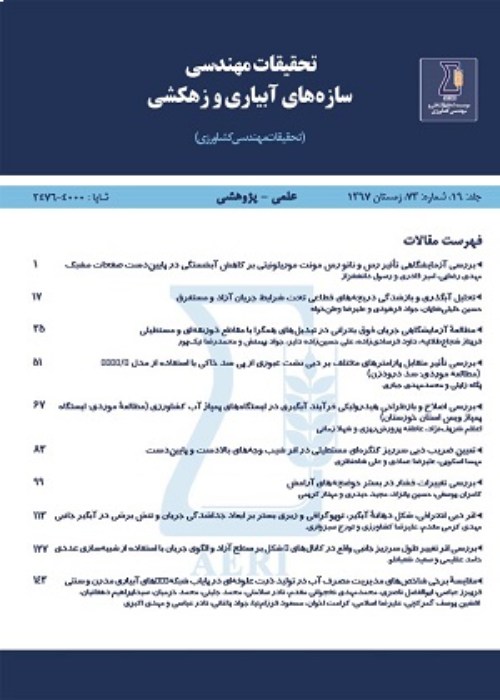Investigating the irrigation water and water productivity in grape production in some orchards of Razavi Khorasan province (Kashmar and Khalilabad)
Water management in the agricultural sector is very important as the largest consumer of water resources in the country. Estimation or determination of water use management indicators, including the amount of water consumed, irrigation efficiency and water productivity of various agricultural and horticultural crops in the country, is one of the most important key indicators in macro-planning related to supply of water, allocation and consumption in different sectors including agriculture. The volume of water used by agricultural crops as one of the indicators for evaluating the optimal use of water resources and plays a very important role in the management and macro-planning in the field of water management and engineering. Grapes is one of the most important horticultural crops in terms of cultivation area, economic and high nutritional values. Iran with an annual production of 2.8 million tons, is among the top countries in the production of grape product in the world. However, there are not accurate information on the volume of irrigation applied water and water productivity of this product inIran. Therefore, this study was conducted with the aim of measurement of applied water at field scale and evaluation of water productivity of grape in vineyards farms at different hubs of this crop production in Khorasan Razavi province.
In Khorasan Razavi province, 2 cities with the highest area under vineyard cultivation were selected for evaluation, Kashmar and Khalilabad. To conduct this research, 6 vineyards in Kashmar region and 6 other vineyards in Khalilabad region have been selected. The volume of irrigation water was measured in these 12 vineyards during the irrigation season. The measurements were carried out in different irrigation and planting methods, various soils, different salinity of irrigation water and soil and different grape varieties during the growing season of 2018-2019 without interfering with the farmer's irrigation management. The measured values were compared with the gross irrigation water requirement estimated by the Penman-Monteith method using the last 10 years meteorological data and also with the national water document values. Crop yield was recorded at the end of the growing season and water productivity was calucated as the ratio of yield to total water (irrigation applied water and effective rainfall). Analysis of variance was used to investigate the possible difference between applied water and water efficiency among the hubs.
The results showed that the amount of applied water, the amount of grape yield and the water productivity in Kashmir region were 12049 m3/ha, 19 ton/ha and 1.76 kg/m3, respectively. The amount of applied water, the amount of grape yield and the water productivity in Khalilabad region were determined as 10827 m3/ha, 27.3 ton/ha and 2.59 kg/m3, respectively. The average amount of applied water and the amount of grape yield in the above two regions were determined as 11146 m3/ha and 23.2 ton/ha, respectively. The average water productivity was calculated as 2.17 kg/m3. The efficiency of water application in selected vineyards in the two regions of Kashmir and Khalilabad was 62.65% and 66.66%, respectively. The average efficiency of water application in the selected vineyards was 64.60%.
According to the latest research conducted (Abbasi et al., 2020), the average amount of irrigation water and water productivity in the country's vineyards are 6669 m3/ha and 2.63 kg/m3, respectively. The average amount of irrigation water and the water productivity in the vineyards of this research area were 11146 m3/ha and 2.17 kg/m3, respectively. By comparing these results with national results, it was concluded that the amount of irrigation water in grape production in Razavi Khorasan Province is about 40.2% higher than the national average and the water productivity is about 17.5% lower than the national average. Considering that the surface irrigation method is often used to irrigate grape orchards in Razavi Khorasan province, improving the performance of the surface irrigation method by using methods to reduce evaporation such as mulching and using low pressure irrigation methods such as irrigation with hydroflume in order to reduce water consumption should be considered in the short term. For the drip irrigation method, the potential value of water applied efficiency is considered to be 90% Abbasi et al. (Abbasi et al., 2016). In the drip irrigation method, the gross requirement of grape irrigation is calculated (using the Penman-Monteith method and based on the statistics and meteorological data of the last ten years), extracted based on the national water document and the book "Estimation of Water requirement by Garden Plants" respectively. It will be reduced to 7762.9, 8177.8 and 8300.0 m3/ha. Therefore, by changing the irrigation method from surface to drip irrigation, the gross irrigation requirement decreases by 26.3%. Therefore, in the long term, it is recommended to change the surface irrigation method to drip irrigation.
- حق عضویت دریافتی صرف حمایت از نشریات عضو و نگهداری، تکمیل و توسعه مگیران میشود.
- پرداخت حق اشتراک و دانلود مقالات اجازه بازنشر آن در سایر رسانههای چاپی و دیجیتال را به کاربر نمیدهد.


